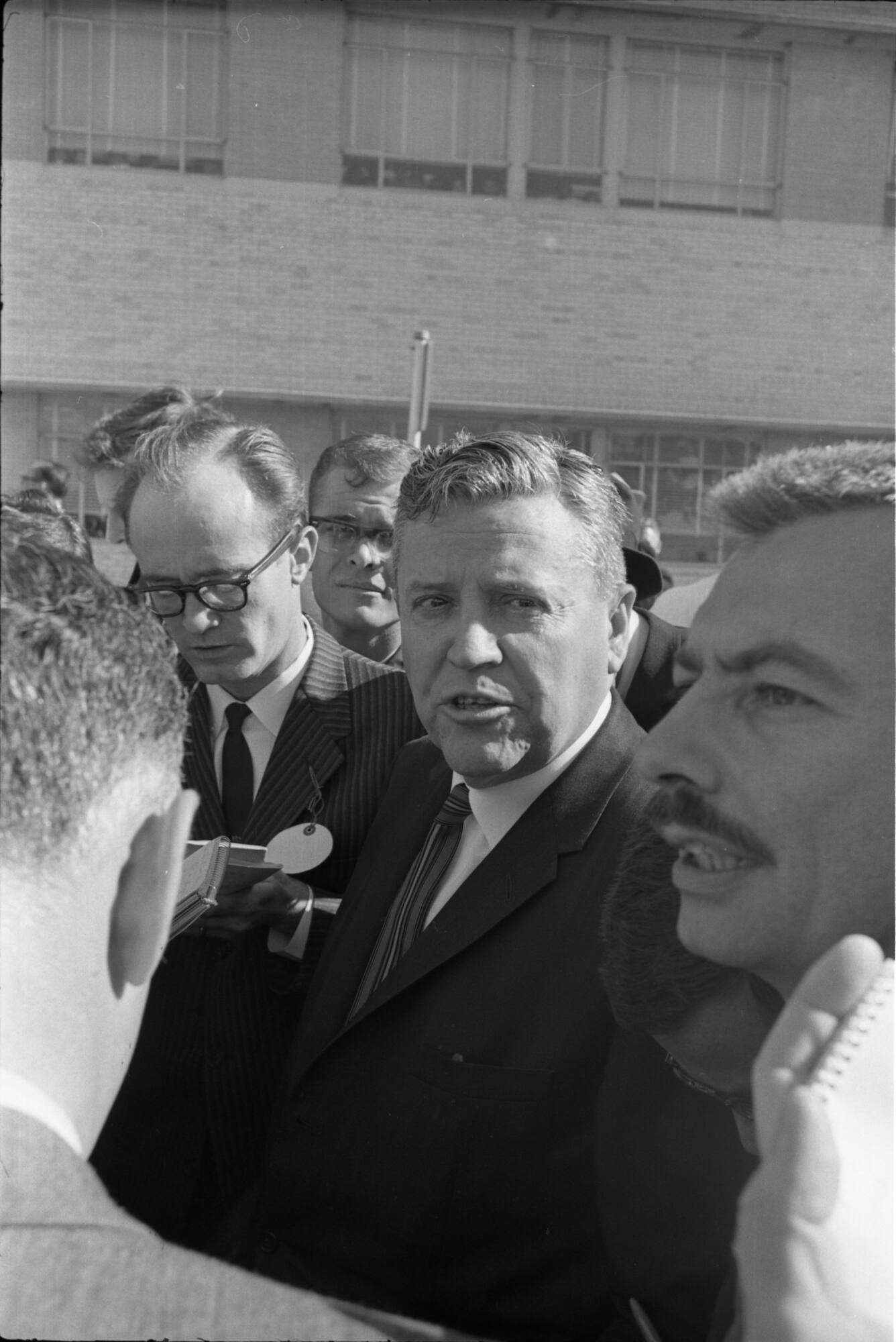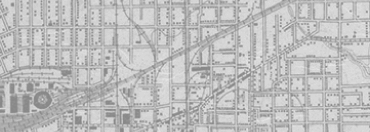


Back
Image of Senator Ralph Yarborough addressing the press at Parkland Hospital
Original 35mm black and white negative taken by Dallas Times Herald staff photographer Eamon Kennedy showing Senator Ralph Yarborough addressing members of the press outside Parkland Hospital on November 22, 1963. Visible in the crowd are Bruce Neal of KXOL Radio (wearing glasses and a pinstriped suit) and Seth Kantor, a Scripps-Howard reporter (with a mustache, on the right).The images on this negative strip were taken by Dallas Times Herald staff photographer Eamon Kennedy. There were three photographers at Parkland Hospital that day: John Mazziotta, Bob Jackson and Eamon Kennedy.
Image of Senator Ralph Yarborough addressing the press at Parkland Hospital
11/22/1963
Film
15/16 x 1 7/16 in. (2.4 x 3.6 cm)
Eamon Kennedy, photographer, Dallas Times Herald Collection/The Sixth Floor Museum at Dealey Plaza
1989.100.0012.0005
Having worked in Dallas in the early 1960s before joining Scripps-Howard, Seth Kantor (far right) knew local nightclub owner Jack Ruby. Kantor later testified to the Warren Commission that he encountered Ruby, shaking his hand and engaging him in brief conversation, at Parkland Memorial Hospital on the day of the Kennedy assassination. Although there is no evidence placing Ruby at Parkland at this time apart from Kantor's controversial firsthand account, conspiracy theorists have suggested that Ruby was there to possibly tamper with assassination-related evidence. Based upon Kantor's account, filmmaker Oliver Stone shows Jack Ruby placing the single or "magic bullet" on a stretcher at Parkland in the 1991 film JFK. Kantor, who passed away in 1993, later wrote the book Who Was Jack Ruby? (1978). - Stephen Fagin, Curator
Seth Kantor told investigators he met acquaintance Jack Ruby at Parkland Hospital the day of the assassination. This controversial assertion has perplexed investigators and theorists ever since, especially for those who believe Ruby may have tampered with evidence at Parkland, including the "magic bullet". Did Seth Kantor speak to Jack Ruby at Parkland or not? What is known is that Ruby went to and remained in The Dallas Morning News advertising office until at least 1:10pm and possibly as late as 1:30pm. While it would have taken at least fifteen minutes to leave that upper floor office, walk to the parking lot and then drive to Parkland, by that hour police had blocked traffic surrounding the hospital. Ruby would have then had to park his car and know precisely where to go inside the hospital and get past police guards who were stationed at various entrances. Later, according to several of his employees and telephone records, Ruby returned to his Carousel Club no later than about 1:35pm. So there seems to be no way Ruby could have gone to Parkland Hospital, placed an incriminating bullet onto a stretcher that may or may not have been connected to the assassination, and then return to his club after parking his car in his regular space.But it is equally hard to understand Seth Kantor insisting that his meeting with Ruby really happened. He had known Ruby for several years, and after his "friend" shot Oswald, Kantor first wrote about his encounter with Ruby the day of the assassination. Stories such as these are food for thought for those convinced that the full story of the assassination has not been told. - Gary Mack, Curator

Image of Senator Ralph Yarborough addressing the press at Parkland Hospital
Original 35mm black and white negative taken by Dallas Times Herald staff photographer Eamon Kennedy showing Senator Ralph Yarborough addressing members of the press outside Parkland Hospital on November 22, 1963. Visible in the crowd are Bruce Neal of KXOL Radio (wearing glasses and a pinstriped suit) and Seth Kantor, a Scripps-Howard reporter (with a mustache, on the right).The images on this negative strip were taken by Dallas Times Herald staff photographer Eamon Kennedy. There were three photographers at Parkland Hospital that day: John Mazziotta, Bob Jackson and Eamon Kennedy.
Image of Senator Ralph Yarborough addressing the press at Parkland Hospital
11/22/1963
Press
Reporter
Photographs
Yarborough, Ralph
Kennedy, Eamon
Mazziotta, John
Kantor, Seth
Neal, Bruce
Dallas Times Herald
Scripps Howard
KXOL station (Ft. Worth)
Parkland Hospital
Dallas
Film
15/16 x 1 7/16 in. (2.4 x 3.6 cm)
Eamon Kennedy, photographer, Dallas Times Herald Collection/The Sixth Floor Museum at Dealey Plaza
1989.100.0012.0005
Having worked in Dallas in the early 1960s before joining Scripps-Howard, Seth Kantor (far right) knew local nightclub owner Jack Ruby. Kantor later testified to the Warren Commission that he encountered Ruby, shaking his hand and engaging him in brief conversation, at Parkland Memorial Hospital on the day of the Kennedy assassination. Although there is no evidence placing Ruby at Parkland at this time apart from Kantor's controversial firsthand account, conspiracy theorists have suggested that Ruby was there to possibly tamper with assassination-related evidence. Based upon Kantor's account, filmmaker Oliver Stone shows Jack Ruby placing the single or "magic bullet" on a stretcher at Parkland in the 1991 film JFK. Kantor, who passed away in 1993, later wrote the book Who Was Jack Ruby? (1978). - Stephen Fagin, Curator
Seth Kantor told investigators he met acquaintance Jack Ruby at Parkland Hospital the day of the assassination. This controversial assertion has perplexed investigators and theorists ever since, especially for those who believe Ruby may have tampered with evidence at Parkland, including the "magic bullet". Did Seth Kantor speak to Jack Ruby at Parkland or not? What is known is that Ruby went to and remained in The Dallas Morning News advertising office until at least 1:10pm and possibly as late as 1:30pm. While it would have taken at least fifteen minutes to leave that upper floor office, walk to the parking lot and then drive to Parkland, by that hour police had blocked traffic surrounding the hospital. Ruby would have then had to park his car and know precisely where to go inside the hospital and get past police guards who were stationed at various entrances. Later, according to several of his employees and telephone records, Ruby returned to his Carousel Club no later than about 1:35pm. So there seems to be no way Ruby could have gone to Parkland Hospital, placed an incriminating bullet onto a stretcher that may or may not have been connected to the assassination, and then return to his club after parking his car in his regular space.But it is equally hard to understand Seth Kantor insisting that his meeting with Ruby really happened. He had known Ruby for several years, and after his "friend" shot Oswald, Kantor first wrote about his encounter with Ruby the day of the assassination. Stories such as these are food for thought for those convinced that the full story of the assassination has not been told. - Gary Mack, Curator









